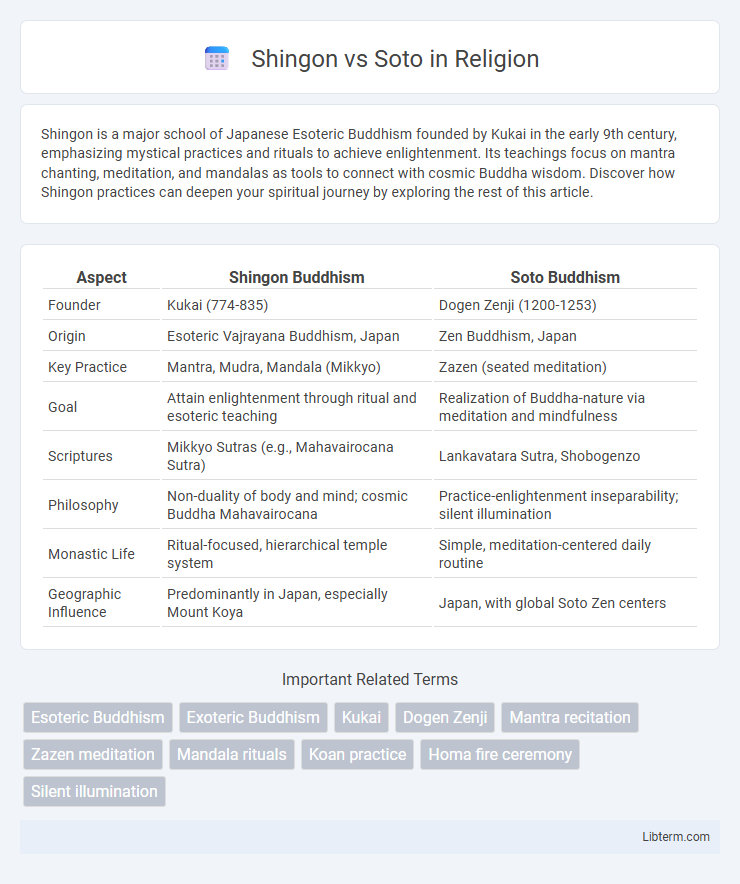Shingon is a major school of Japanese Esoteric Buddhism founded by Kukai in the early 9th century, emphasizing mystical practices and rituals to achieve enlightenment. Its teachings focus on mantra chanting, meditation, and mandalas as tools to connect with cosmic Buddha wisdom. Discover how Shingon practices can deepen your spiritual journey by exploring the rest of this article.
Table of Comparison
| Aspect | Shingon Buddhism | Soto Buddhism |
|---|---|---|
| Founder | Kukai (774-835) | Dogen Zenji (1200-1253) |
| Origin | Esoteric Vajrayana Buddhism, Japan | Zen Buddhism, Japan |
| Key Practice | Mantra, Mudra, Mandala (Mikkyo) | Zazen (seated meditation) |
| Goal | Attain enlightenment through ritual and esoteric teaching | Realization of Buddha-nature via meditation and mindfulness |
| Scriptures | Mikkyo Sutras (e.g., Mahavairocana Sutra) | Lankavatara Sutra, Shobogenzo |
| Philosophy | Non-duality of body and mind; cosmic Buddha Mahavairocana | Practice-enlightenment inseparability; silent illumination |
| Monastic Life | Ritual-focused, hierarchical temple system | Simple, meditation-centered daily routine |
| Geographic Influence | Predominantly in Japan, especially Mount Koya | Japan, with global Soto Zen centers |
Introduction to Shingon and Soto Buddhism
Shingon Buddhism, founded by Kukai in the early 9th century, emphasizes esoteric practices, mantra chanting, and complex rituals aimed at achieving enlightenment in this lifetime. Soto Buddhism, founded by Dogen in the 13th century, centers on zazen meditation and the doctrine of shikantaza, or "just sitting," highlighting a direct, experiential approach to awakening. Both traditions play significant roles in Japanese Buddhism, with Shingon focusing on mystical teachings and Soto on meditative practice.
Historical Origins of Shingon and Soto
Shingon Buddhism, founded in the early 9th century by Kukai, emphasizes esoteric practices and rituals rooted in Vajrayana traditions brought from China's Tang dynasty. Soto Buddhism, introduced in the 13th century by Dogen Zenji, centers on silent meditation (zazen) and fosters an approach derived from Chinese Caodong Zen lineage. Both schools significantly shaped Japanese Buddhism, with Shingon focusing on mystical teachings and Soto promoting an accessible, practice-based path.
Key Philosophical Differences
Shingon Buddhism emphasizes esoteric practices and rituals centered around mantra, mudra, and mandala to attain enlightenment in this lifetime, highlighting the concept of Buddha-nature inherent in all beings. Soto Zen centers on zazen meditation with a focus on shikantaza, or "just sitting," promoting gradual awakening through continuous practice and emphasizing the inherent enlightenment in everyday activities. The key philosophical difference lies in Shingon's ritualistic and symbolic approach to realization versus Soto's direct, non-conceptual meditation and the expression of enlightenment in daily life.
Core Practices: Rituals and Meditation
Shingon Buddhism emphasizes intricate esoteric rituals, mantra chanting, and mandala visualization to achieve spiritual awakening through direct experience of Buddhahood. Soto Zen prioritizes zazen, a form of seated meditation focusing on mindful breath awareness and posture to cultivate silent insight and presence. Both traditions use meditative practices but diverge in Shingon's ritual complexity and Soto's simplicity and emphasis on direct, non-symbolic meditation.
Important Texts and Scriptures
Shingon Buddhism centers around the Mahavairocana Sutra and the Vajrasekhara Sutra, which emphasize esoteric rituals and mantra practices essential to its tantric teachings. Soto Zen prioritizes the Shobogenzo, a collection of writings by Dogen Zenji that focuses on the philosophy and practice of zazen (sitting meditation) and enlightenment in everyday life. Both traditions use their core texts to guide spiritual practice, with Shingon emphasizing ritual transmission and Soto highlighting direct experience through meditation.
Role of Monastic Life in Both Schools
Shingon Buddhism emphasizes an esoteric monastic tradition where rituals, mandalas, and mantra chanting play a central role in attaining enlightenment, fostering disciplined spiritual practice within monastery settings. Soto Zen prioritizes zazen meditation as the core monastic practice, focusing on silent sitting and mindfulness to realize Buddha-nature in everyday life without reliance on ritual complexity. Both schools uphold monastic life as essential for rigorous training, though Shingon centers on ritual mastery while Soto emphasizes meditative awareness and simplicity.
Symbolism and Iconography Compared
Shingon Buddhism emphasizes complex mandalas and esoteric symbols such as the Womb Realm Mandala and Vajra, representing cosmic principles and enlightenment through ritualistic iconography. Soto Zen features minimalist aesthetics, prioritizing zazen meditation and simpler representations like the enso circle, symbolizing enlightenment, emptiness, and the present moment. The contrast highlights Shingon's rich ritual symbolism versus Soto's focus on direct experience and simplicity in visual expression.
Notable Masters and Figures
Kukai, founder of Shingon Buddhism, emphasized esoteric rituals and mandalas, influencing Japanese spiritual practices profoundly. Eihei Dogen, the founder of Soto Zen, promoted "shikantaza" or "just sitting" meditation, shaping Soto's meditative discipline and philosophical outlook. Both masters established distinct schools with enduring lineages, highlighting differences in ritual complexity and meditation approaches.
Influence on Japanese Culture and Society
Shingon Buddhism introduced esoteric rituals and mandalas that deeply influenced Japanese art, architecture, and religious ceremonies, fostering a tradition of mystical practice and temple culture. Soto Zen emphasized zazen meditation and simplicity, shaping Japanese aesthetics, tea ceremony, and martial arts through its focus on mindfulness and everyday presence. Both sects contributed to Japan's spiritual landscape by integrating doctrinal teachings with cultural rituals that continue to impact contemporary Japanese society.
Modern-Day Relevance and Global Presence
Shingon Buddhism emphasizes esoteric rituals and mantra practices, preserving traditional teachings with significant influence in Japan and select global centers, appealing to those interested in mystical experience. Soto Zen centers on seated meditation (zazen) and simplicity, fostering mindfulness and widespread practice through numerous international temples and lay communities. The global presence of Soto Zen, particularly in Western countries, outpaces Shingon, but Shingon's rich ritualistic heritage attracts a dedicated following seeking deeper spiritual symbolism.
Shingon Infographic

 libterm.com
libterm.com